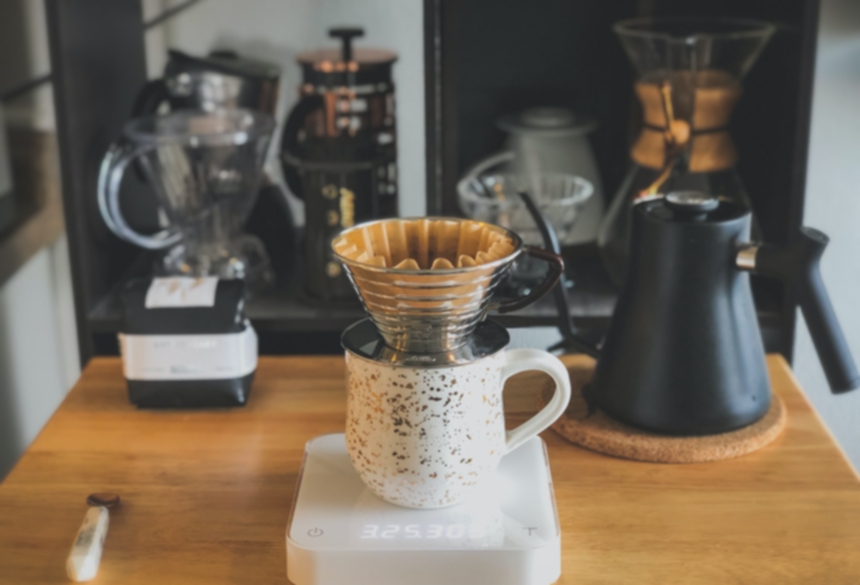The Beginner's Guide to Pour-Over Coffee: Essential Equipment
"I'm a coffee novice, looking for a simple utensil for pour-over coffee, but I'm not familiar with the brand, and I'm afraid of buying the wrong one."
"I bought coffee beans and want to make my own coffee, but I don't know how to start... What utensils do I need to prepare?"
Here we will show you to prepare five utensils to brew a good cup of coffee, and even beginners can easily get started:
1. Grinder
To choose the appropriate grinder, there are the following key points:
According to the selection points of the above three grinders, it is recommended not to buy a blade grinder (in addition to the inability to adjust the grinding size accurately, it will generate heat during operation, thereby destroying the quality of coffee beans.
In addition, turn on the power of the grinder first, let the grinder run and then drop the coffee beans to grind, or put in the coffee beans first, then turn on the power of the grinder and grind the beans, there will be the size distribution (particle size) between the two. ) if you have a grinder at home, you might as well try it.(It is recommended to turn on the power first and then drop the beans)
2. Scales
A scale that can accurately measure the weight of coffee beans to 0.1 grams. (If there is a scale, it is not recommended to use a spoon or a bean spoon for measurement. The coffee beans will be different in size, which will affect the total weight of coffee beans per tablespoon, resulting in extraction errors, volume ≠ weight)
Using the scale, you can see the amount of water injected so that the water injection is no longer based on feeling. The actual coffee bean weight and water volume can be maintained at the expected value (powder-water ratio).
In addition, friends who require more precision can weigh the powder instead of the beans. After the weighted coffee beans are ground, there may be residual powder in the grinder, causing a slight weight error. Pre-weighing is like a requirement. For coffee beans with a little more powder, the possibility of error can be minimized by weighing them after grinding.
3. Filter
The filter can be mainly divided into trapezoidal and conical filter, which can be brewed with filter paper, the metal filter, or filter cloth.
And we recommend using the smart filter because the brewing process is very simple, no special skills are required, the operation is easy to use, and the cleaning and maintenance are also convenient. Combined with the concept of brewing + brewing, water is injected first and then soaked, and the use of smart filter cups can present the original style of coffee.
The only difference in taste between using filter paper and metal filters is that the filter paper will be fresher and sweeter. In contrast, the filter will retain the lubricating flavor of coffee oil but with higher turbidity.
When using filter paper, it is recommended to soak the filter paper with hot water to remove the paper smell, and the brewed coffee will have a better flavor.
4. Pour-Over pot
Here we recommend a temperature-controlled pour-over pot. According to personal habits, you can choose a pour-over pot with different weights. For example, women can choose a pour-over pot with a capacity of 600ml, which can better control the stability of the water flow.
In addition, the difference between the spout and the material of the pour-over pot will affect the water output, water flow speed, temperature preservation, thermal conductivity, and other factors. Using a suitable pour-over pot can control water flow so that the water and coffee grounds can be mixed evenly.
5. Thermometer/Timer
Thermometer: If the pour-over brewer does not have a temperature control function, it is recommended to use an electronic thermometer inserted in the water of the pour-over brewer to check the current water temperature. Water temperature is a major factor in coffee brewing. Astringency, if the water temperature is too low, the coffee flavor will not be displayed, and the extraction will be insufficient.
The entire thermometer can be immersed in at least 2/3 of the ice water with ice cubes added. If it shows zero degrees, the thermometer is accurate.
Timer: If the scale does not have a timer function, a timer will be required to record each time point during brewing, including the time of starting water injection, steaming, stirring time, descending time, and stopping extraction time, etc. (Phones should now have a timer function.)
Finally, you've learned what equipment to buy as a coffee pouring beginner. If you want to learn more about coffee, whether it's other brewing methods, coffee facts, or some coffee market information, you can visit roastercoffees.com for more coffee resources so you can brew more delicious coffee at home.

